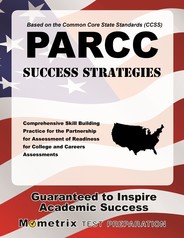The mission of Partnership for Assessment of Readiness for College and Careers (PARCC) is to ensure all students are prepared for college and the workplace. The PARCC assessments are used to determine college readiness and career preparedness in kindergarten through grade twelve students.
These assessments are used to help students and parent determine if they are on target in meeting their long-term goals and are used to assist teachers in developing curriculum in compliance with the Common Core State Standards.
At this time, there are thirteen states that participate in PARCC, and collectively, this amount is more than 12 million students in the kindergarten through grade twelve public schools.
This collaboration among states is a good way to set academic standards and benchmarks in an effort to create a higher-quality assessment.
PARCC is aligned to the Common Core State Standards because it sets clear, consistent guidelines at each grade level.
There are many contributors to PARCC, those being education leaders nationwide, advisory boards, technical groups, steering committees, operational working groups, content leads, and postsecondary leadership teams.
The assessments are computer based. They are designed to measure performance in math, language arts, and literacy.
The kindergarten through grade two assessments help track foundational knowledge of students through checklists, classroom activities, observations, and other protocols.
Free PARCC Practice Test Question Directory
The PARCC English language arts and literacy assessment is built around a reading and writing component. The reading section is evaluated by text complexity, reading comprehension, and cited resources. These assessments are used to evaluate a student’s ability to draw conclusions, inferences, and generalizations.
The writing segment of the assessment helps to evaluate a student’s ability to develop ideas, organize his or her writing, and grammar and language usage. PARCC math is effective in evaluating competencies in modeling, reasoning, and practices.
A further example of how the assessments are designed is by looking at the PARCC grades three through eight and high school assessments. The grades three through eight PARCC and high school PARCC assessments have four components to measure student achievement: two summative sections, which are performance based and are implemented after three-quarters of the school year.
The assessments focus on writing and analyzing text. The third assessment is math performance based and measures the skills and knowledge of mathematical concepts, multistep programs, abstract reasoning, and use of tools. The last component of the assessment is distributed at the very end of the school year. This section focuses on reading comprehension and a deeper conceptual understanding of math.
There are three non-summative portions of the assessment, but only two are required. The non-summative portion may consist of a diagnostic assessment that is used to measure student knowledge and skills as they relate to professional development.
A second kind of non-summative assessment is the midyear assessment, which is performance based and used to measure standards that are typically difficult to gather. Last, there is a speaking and listening assessment that could be used to measure a student’s ability to communicate and comprehend ideas.
At the present time, the median estimated cost to provide the PARCC is less than $30 a student per year. The initial start-up cost may be a little higher in that pencil-and-paper administration may be required before the technology is in place.
Administration costs may be adjusted in the future as technology continues to evolve. The consortium of expertise and information that PARCC provides is an innovative and strategic way to develop students for the demands of the current generation.
Self Assessment Modules
- Basic Algebra
- Intermediate Algebra
- Advanced Algebra
- Arithmetic
- Commas
- Estimation and Sequences
- Exponents
- Fractions and Square Roots
- Geometry
- Basic Grammar
- Intermediate Grammar
- Advanced Grammar
- Graphs
- Basic Math
- Intermediate Math
- Advanced Mathematics
- Measurement
- Nouns
- Percents and Ratios
- Author's Purpose
- Basic Reading Comprehension
- Intermediate Reading Comprehension
- Advanced Reading Comprehension
- Reading for the Main Idea
- Reading Vocabulary
- Sentence Correction
- Sentence Flow
- Word Usage Test 1
- Word Usage Test 2
- Word Usage Test 3
- Verbs
- Writing Section 1
- Writing Section 2




 Get Your Study Guide
Get Your Study Guide Get Your Flashcards
Get Your Flashcards